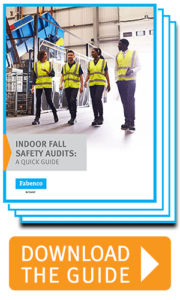
A busy loading dock is a source of pride for many chief executive officers. The buzzing activity means they own a thriving business. Unfortunately, this constant traffic can make loading dock safety a tricky situation — especially when transportation to and storage on mezzanines is involved. Instead of relying on fancy footwork and crossed fingers, let’s take a closer look at how a bit of forethought can prevent accidents on your loading dock.

- Which trailers visit your loading area?
- What system does your company use to secure trailers?
- How do you secure your dock area?
- What communication systems do you rely on?
- Do you use a swing gate or other dock gates as part of your loading dock safety procedures?
These experts can create a safety protocol that works for your company. In the meantime, you can also use the tips below to make your loading dock a safer place.
Part One: Implementing Loading Dock Safety
1. Establish a Safe Sequence of Operations for Workers
Just a few decades ago, workers manually operated equipment like levelers, overhead doors, and vehicle restraints. Thankfully, today’s technological advancements have streamlined the process. Many workers can load or unload items with the touch of a button.
Even with this technology, mistakes can still happen. Trailers in reverse, automated doors, forklifts, and blind spots — you get the picture. To help avoid a dangerous situation, establish a safe sequence of operations for your employees to follow so there’s no confusion as to what’s happening when.
2. Use Guardrail Systems
OSHA requires companies to install guardrail systems along the working side of a loading dock’s platform that is normally 44 to 48 inches high (1910.28(b)(1)). Most trucks (straight, semi-trailers, and flatbeds) have beds that align with them. Keep in mind, refrigerated trucks have a 50 to 60-inch bed height, so you’ll need to use a guardrail system to prevent workers from falling.
3. Install A Swing Gate
You have several good reasons to use a swing gate at your loading dock. A self-closing swing gate protects workers and takes the guess work out of safety. A vertical-lift gate makes it easy to control access to your loading dock, prevent falls, and allows materials to come in and out of the building without taking up horizontal space during operation. And many safety gates can be installed with your existing guardrails or with simple receiver posts.
4. Install LED Lighting Systems and Motion Sensors
Light signaling devices are commonly used in warehouses. These loading dock safety systems combine LED lighting and audible alarms to communicate clear traffic warnings to dock workers. Likewise, motion sensors are an excellent way to detect and halt activity on or near your loading dock before an accident happens.
5. Use Retractable Visual and Physical Barriers
Physical barriers help reduce accidents in these loading dock areas. They alert employees when visual or sound-based communication is impossible.
6. Keep it Clean
Make sure there are no spills or debris that can cause slips, trips, and falls. Secure loose inventory, and lock up all vehicles not in use.
Part Two: Protecting Your Mezzanine Levels
Mezzanines are a smart use of square footage in a warehouse, factory or manufacturing facility — they help companies to expand their facilities without leasing more space. Unfortunately, the convenience of mezzanines has a downside: having an open elevation means you have another area that needs a set of safety protocols:
1. Handrails
Mezzanine levels need to follow OSHA standards that address slip, trip, and falls, just like all walking-working surfaces. That likely means installing handrails. Before you install yours, check out OSHA’s guidelines:
- Handrail systems – A stair rail system’s height should not be less than 42 inches (107 cm) from the leading edge of the stair’s tread to the top surface of the top rail. 1910.29 (f)(1)(11)(B)
- Top rails may only serve as a stair rail system under the following circumstances. – The height of the stair rail system should not be less than 36 inches (91 cm) and not more than 38 inches (97 cm) as measured at the leading edge of the stair’s tread to the top surface of the highest rail. 1910.29(f)(1)(iii)(A)
- Finger Clearance – The minimum clearance for handrails (and other objects) is 2.25 inches (5.7 cm). 1910.29(f)(2)
- Surfaces – Handrails should have smooth-surfaces to protect employees from punctures, lacerations, and other injuries. 1910.29(f)(3)
- Handholds – Handrails must have a shape and dimension that workers can grasp firmly. 1910.29(f)(5)
- Openings in Stair Rails – Openings in a stair rail system should not exceed 19 inches (48 cm) at its least dimension. 1910.29(f)(4)
- Strength Criteria – Handrails and top rails should be capable of withstanding, without failure, a force of 200 pounds (890 N) in a downward or upward direction within 2 inches (5 cm) of any point along the top edge of the rail. 1910.29(f)(7)
2. Use Mezzanine Gates
OSHA requires companies to use safety gates on mezzanines. These mezzanine gates help keep employees safe while working. Construction sites can invest in several types of mezzanine safety gates, like a vertical sliding gate, a swing gate, or a pivot gate. Mezzanine gates are a convenient way to keep your workers and your cargo safe while materials are delivered to your mezzanine level via forklift.
3. Protect Ladders and Stairwells
Ladders and stairwells are often forgotten when considering loading dock safety. Whether you use guardrails and a swing gate or a ladder guarding device, keep stairways and ladders protected to prevent unwanted access to mezzanine levels.
The best way to make sure your loading dock and mezzanine level are up to code is to consult with an expert. That way, you’ll not only be sure you are OSHA compliant, but creating a safe workspace for your employees — no matter how busy your loading dock gets. Have questions? Feel free to call an expert at Fabenco today.











